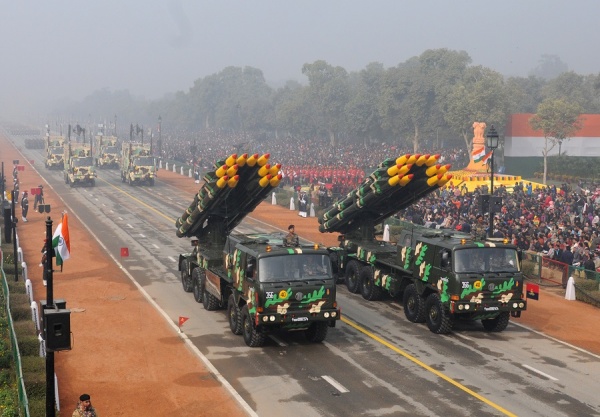
Any ambiguity regarding Pakistan’s plans to develop tactical nuclear weapons (TNWs) was removed by Gen. Khalid Kidwai, former head of the SPD and advisor to Pakistan’s National Command Authority, at the 2015 Carnegie International Nuclear Policy Conference. Kidwai reiterated that the rationale for developing TNWs was to deter India from using its conventional superiority in a low-scale attack as part of a proposed Indian military doctrine, Cold Start.
Pakistan’s decision to develop TNWs has raised concerns for India and the world. Arguably to counter India’s Cold Start, Pakistan has lowered its nuclear threshold in a way that takes away the space for India to lauch a conventional attack against Pakistan as a response to either its proxy war in Jammu and Kashmir or a Mumbai-style state-sponsored terror attack.
Despite doubts as to whether or not Pakistan has developed and deployed TNWs, the signals sent by its scientists and the army have to a degree affirmed TNWs as an important pillar of Pakistan’s nuclear doctrine. The development of short-range missiles such as Nasr and Abdali and the rapid increase in the production of fissile material must be noted in this light. There is a general agreement in India as well that the introduction of TNWs significantly lowers Pakistan’s nuclear red lines to make the use of conventional superiority even in a low-scale incursion or attack by India a highly risky venture. While it is true that the Indian government has declined Cold Start as an official doctrine, it simultaneously cannot be denied that a conventional attack has been an option that India would use as a response to Pakistan’s proxy wars. The introduction of TNWs has, therefore, worked well for Pakistan.
In order to utilise its conventional superiority, New Delhi could consider developing TNWs that credibly deter Pakistan from using its own in the first place. In fact, debates in India regarding the development of TNWs have already begun. On one hand, there remain experts such as Manpreet Sethi who argue that India need not build its own TNWs; India could respond to Pakistan’s threat of using TNWs by focusing on measures that convince Pakistan of “an inevitability of nuclear retaliation to any nuclear use, irrespective of yield, target or damage.” On the other hand, experts such as Manoj Joshi and Brahma Chellaney call on India to acquire multiple nuclear options along the ladder of escalation. They argue that the development of TNWs will benefit India in two ways. Firstly, it will give India options of proportionate response should deterrence fail. Secondly, retaining nuclear options along the escalatory ladder will provide the opportunity for a settlement at a low-scale nuclear exchange before the situation escalates to the strategic levels. But whether developing TNWs allows India to counter Pakistan’s TNWs and to find space below the lowered threshold of Pakistan to use its conventional superiority remains unanswered.
The Indian government has so far avoided developing TNWs to deter Pakistan or to use in case deterrence fails. This has led many experts to question the credibility of India’s nuclear doctrine, in particular the use of “massive retaliation.” Despite the criticism, India has argued that its strategic weapons are capable of deterring the use of TNWs by Pakistan. It is in this context that Shyam Saran’s argument on the absence of any difference between tactical and strategic nuclear weapons can be better understood. New Delhi is reluctant to develop TNWs and is using arguments such as geographical proximity and the inevitable escalation to strategic levels as justification. Besides the complexities involved in the command and control of TNWs and the inherent risks of accidental use, there are two possible factors that may have caused this reluctance.
First is the need for India to act as a responsible nuclear power. India has faced severe international criticism and was been subject to sanctions after 1974, when it conducted the nuclear test. Decades of India’s nuclear apartheid are, however, ending with India’s gradual integration into the global nuclear order. The path to the U.S.-India civil nuclear cooperation and the subsequent NSG waiver, however, has been difficult due to strong opposition from the nuclear nonproliferation lobby. It has been India’s practice of restraint and responsible behaviour that has allowed for India’s gradual accommodation into the global nuclear order. As India transits from the periphery to the centre of this nuclear order, the development of TNWs would run against its responsible behaviour and will be counter-productive.
Second is the state of relations between the civil and military establishments in India. In his “posture optimization theory,” Vipin Narang identifies four sequenced variables that can be used to predict a nation’s nuclear force structure and posture. One of these four sequenced variables is the civil-military arrangement. In a state where the civil-military arrangement is assertive (wherein the civilian government exercises tight control over the military establishment), it is unlikely that the military will enjoy wide freedom of action in questions of defence policy and nuclear doctrine. Narang cites India’s case as that of an assertive civil-military arrangement. It can, therefore, be argued that with strong control of the civilian government in New Delhi over India’s military, it is unlikely that India will develop TNWs, as this would require the delegation of launch authorities to the military.
These two factors must, however, not be seen as constants. As India becomes further integrated into the global nuclear order and as the civil-military equation evolves, this reluctance to develop TNWs may fade. But for now, India will benefit by not engaging in the development of TNWs. Does this mean that India has no answers to Pakistan’s TNWs? Pakistan has developed TNWs to deter a conventional attack by India, allowing it to continue its proxy war against the latter. Pakistan’s TNWs are thus only relevant against an Indian conventional attack. India can, therefore, make Pakistan’s TNWs irrelevant by developing responses other than a conventional attack to a Pakistani-sponsored Mumbai-style terror attack or its proxy war in Jammu and Kashmir.
***